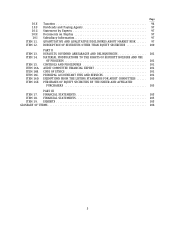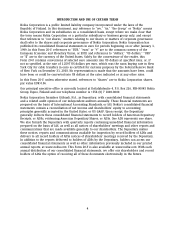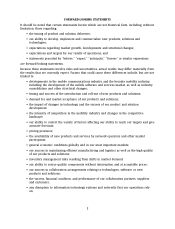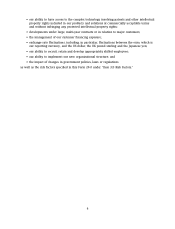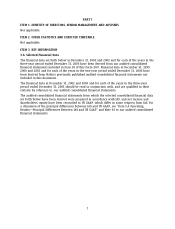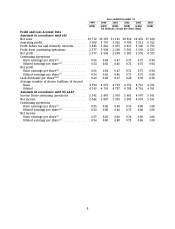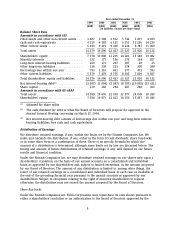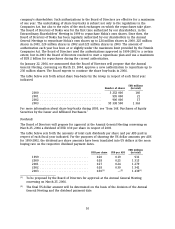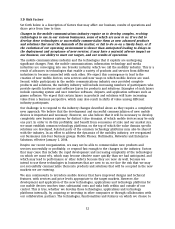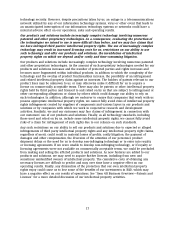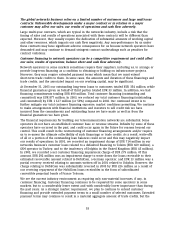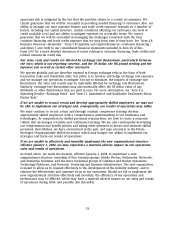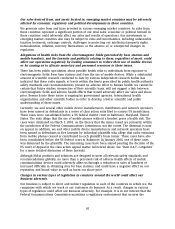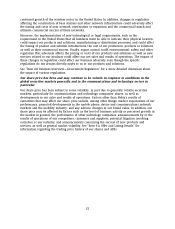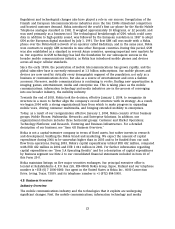Nokia 2003 Annual Report Download - page 14
Download and view the complete annual report
Please find page 14 of the 2003 Nokia annual report below. You can navigate through the pages in the report by either clicking on the pages listed below, or by using the keyword search tool below to find specific information within the annual report.focus may not achieve as broad customer acceptance as we expect. This may result from
numerous factors including the availability of more attractive alternatives or a lack of sufficient
compatibility with other existing technologies, products and solutions. Additionally, even if we do
select the technologies, functionalities and features that customers ultimately want, we or our
collaboration partners may not be able to bring them to the market at the right time.
We believe that the success of the mobility industry and our success depend significantly on the
timely development of a global business environment that is conducive to the mass-market
acceptance of new services to be delivered over various kinds of networks. In order for such an
environment to develop, we believe that existing market fragmentation of various kinds needs to
be reduced. Market fragmentation can exist as a result of certain national business, legal and
governance structures; for example, certain services, such as payment processing by banks, have
traditionally been organized at the national rather than international level, with the result that
service offerings are not consistent across borders. As well, the adjustment to network-based
delivery of services in many instances requires substantial changes to existing industry value
chains and business models, and these changes are either not yet implemented or may develop in
ways inconsistent with the aim of a globally coherent mobile business environment. Finally,
market fragmentation can result from technological barriers such as a lack of interoperability.
Because the value of networked services is directly related to the number of users who become
connected to networks and are able to use those services, we believe that the mobility industry
will have to reduce the fragmentation described above by coordinating business and service
solutions across traditional national and industry borders. As well, from a technological
perspective, the avoidance of fragmentation will require the widespread support of
interoperability in products and services across all service and consumer platforms—not only
mobile devices—through open, global specifications and standards.
Nevertheless, although we invest significantly in the development of global standards and in their
promotion worldwide, and implement open standards in our products and solutions, other market
participants and end-users may not implement or adapt to them or may be delayed in
implementing the often significant business model or value chain adjustments that would be
necessary to reduce overall fragmentation in the market. We believe that failure or delays in these
business model and value chain adjustments or in the creation and implementation of open,
global standards may result in reduced long-term growth of the overall market, scarcity of
interoperable products and solutions, increased market fragmentation and fewer innovative
entrants to the market. For further information, see ‘‘Item 4.B Business Overview.’’
In our networks business, we are developing a number of network infrastructure solutions
incorporating advanced technologies. Currently, our networks business designs and builds
networks based primarily on GSM, EDGE and WCDMA technologies. Although these are currently
the leading mobile communications technology platforms, they may not always be. Our networks
business’s sales and operating results may be adversely affected if these technologies or
subsequent new technologies on which we focus do not achieve as broad acceptance among
customers as we expect, or if we fail to adapt to different technology platforms that emerge over
time.
The development of the mobility industry is significantly altering the competitive landscape
and increasing competition. We are entering businesses where the competitive landscape is
new to us or still in the early stages of development. Our failure to respond successfully to
this development may have a material adverse impact on our business, our ability to meet
our targets, and our results of operations.
The markets for our products and solutions are intensely competitive. Industry participants
compete with each other mainly on the basis of the breadth and depth of their product portfolios,
13


